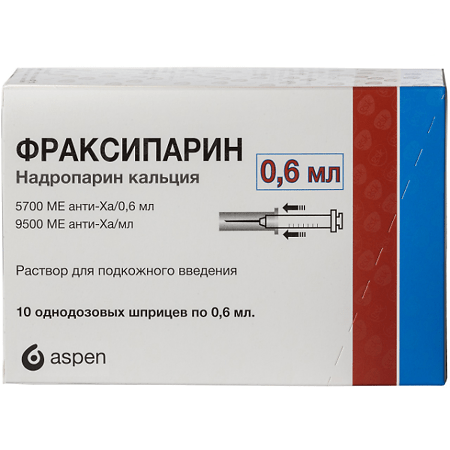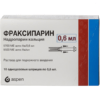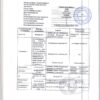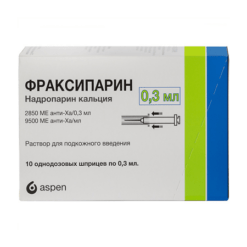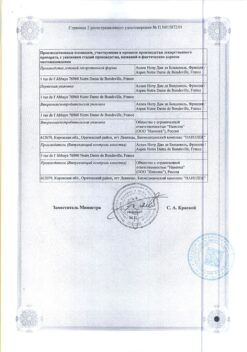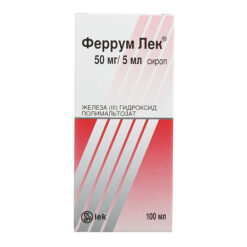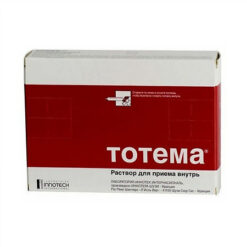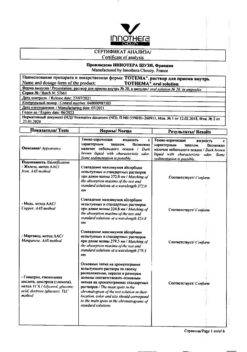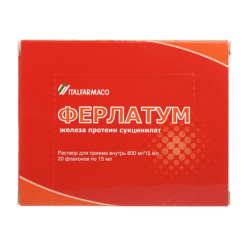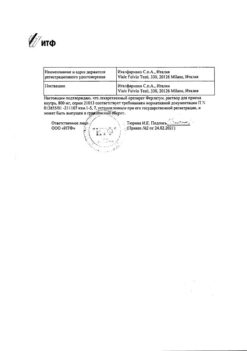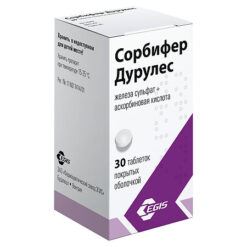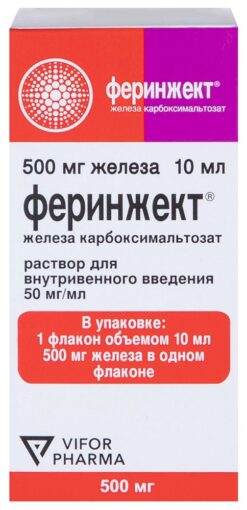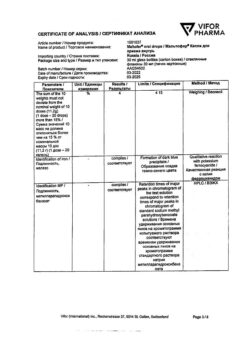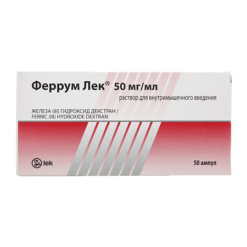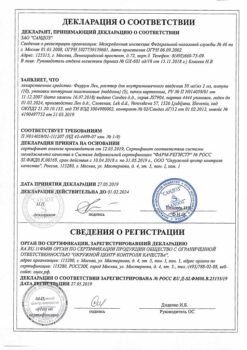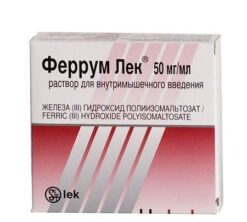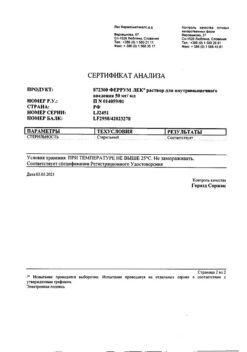No products in the cart.
Frauxiparin 9,500 anti-Xa IU/ml /5700 IU anti-Xa /0.6 ml 0.6 ml syringes, 10 pcs.
€1.00
Out of stock
(E-mail when Stock is available)
Description
Fraxiparin is a low molecular weight heparin (LMWH) obtained by depolymerization from standard heparin and is a glycosoaminoglycan with an average molecular weight of 4300 daltons.
It exhibits a high ability to bind to the plasma protein antithrombin III (AT III). This binding leads to accelerated inhibition of factor Xa, which explains the high antithrombotic potential of nadroparin. Other mechanisms providing antithrombotic effect of nadroparin include activation of tissue factor conversion inhibitor (TFPI), activation of fibrinolysis by direct release of tissue plasminogen activator from endothelial cells and modification of blood rheological properties (decrease of blood viscosity and increase of membrane permeability of platelets and granulocytes).
Nadroparin calcium is characterized by higher anti-Xa factor activity compared to anti-IIa factor or antithrombotic activity and has both immediate and prolonged antithrombotic activity. Compared with unfractionated heparin, nadroparin has less effect on platelet function and aggregation and little effect on primary hemostasis. In prophylactic doses, nadroparin does not cause a pronounced decrease in the BHRT.
In case of course treatment during the period of maximum activity it is possible to increase Frequency Deviation Time Values up to 1.4 times the standard value. This prolongation reflects the residual antithrombotic effect of calcium nadroparin.
Indications
Indications
– Prevention of thromboembolic complications during surgical and orthopedic interventions in patients with a high risk of thrombosis (acute respiratory and/or heart failure in ICU conditions, unstable angina, myocardial infarction without a pathological Q wave on the ECG).
– Treatment of thromboembolism.
– Prevention of blood clotting during hemodialysis.
Pharmacological effect
Pharmacological effect
Fraxiparin, a low molecular weight heparin (LMWH), obtained by depolymerization from standard heparin, is a glycosaminoglycan with an average molecular weight of 4300 daltons.
Shows a high ability to bind to the blood plasma protein antithrombin III (AT III). This binding leads to accelerated inhibition of factor Xa, which accounts for the high antithrombotic potential of nadroparin. Other mechanisms mediating the antithrombotic effect of nadroparin include activation of tissue factor converting inhibitor (TFPI), activation of fibrinolysis through direct release of tissue plasminogen activator from endothelial cells, and modification of blood rheological properties (decreasing blood viscosity and increasing platelet and granulocyte membrane permeability).
Nadroparin calcium is characterized by higher anti-Xa factor activity compared to anti-IIa factor or antithrombotic activity and has both immediate and prolonged antithrombotic activity. Compared with unfractionated heparin, nadroparin has a lesser effect on platelet function and aggregation and a less pronounced effect on primary hemostasis. In prophylactic doses, nadroparin does not cause a significant decrease in aPTT.
During a course of treatment during the period of maximum activity, it is possible to increase the aPTT to a value 1.4 times higher than the standard one. This prolongation reflects the residual antithrombotic effect of nadroparin calcium.
Active ingredient
Active ingredient
Nadroparin calcium
Composition
Composition
1 syringe contains nadroparin calcium 5700 IU anti-Xa.
Pregnancy
Pregnancy
Currently, there is only limited data on the penetration of nadroparin through the placental barrier in humans.
Therefore, the use of Fraxiparine during pregnancy is not recommended, unless the potential benefit to the mother outweighs the risk to the fetus.
Currently, there are only limited data on the excretion of nadroparin in breast milk.
In this regard, the use of nadroparin during lactation (breastfeeding) is not recommended.
Experimental studies on animals did not reveal a teratogenic effect of nadroparin calcium.
Contraindications
Contraindications
– Thrombocytopenia with the use of nadroparin in the anamnesis.
– Signs of bleeding or increased risk of bleeding associated with impaired hemostasis (except for disseminated intravascular coagulation not caused by heparin).
– Organic diseases with a tendency to bleeding (for example, acute gastric or duodenal ulcers).
– Injuries or surgical interventions on the brain, spinal cord or eyes.
– Intracranial hemorrhage.
– Acute septic endocarditis.
– Severe renal failure (creatinine clearance less than 30 ml/min) in patients receiving Fraxiparine for the treatment of thromboembolism, unstable angina and non-Q wave myocardial infarction.
– Children and adolescence (up to 18 years).
– Hypersensitivity to nadroparin or any other components of the drug.
Fraxiparine should be prescribed with caution in situations associated with an increased risk of bleeding: with liver failure, with renal failure, with severe arterial hypertension, with a history of peptic ulcers or other diseases with an increased risk of bleeding, with circulatory disorders in the choroid and retina of the eye, in the postoperative period after operations on the brain, spinal cord or eyes, in patients weighing less than 40 kg, with a duration of therapy, exceeding the recommended (10 days), in case of non-compliance with the recommended treatment conditions (especially increasing the duration and dose for course use), when combined with drugs that increase the risk of bleeding.
Side Effects
Side Effects
The most common side effect is the formation of a subcutaneous hematoma at the injection site. In some cases, the appearance of dense nodules is observed, which does not indicate heparin encapsulation, which disappear after a few days.
Large doses of Fraxiparine can provoke bleeding of various localizations and mild thrombocytopenia (type I), which usually disappears with further therapy. A temporary moderate increase in the level of liver enzymes (ALT, AST) is possible.
Skin necrosis and allergic reactions occur rarely. Several cases of anaphylactic reactions and immune thrombocytopenia (type II) associated with arterial and/or venous thrombosis or thromboembolism have been reported.
Interaction
Interaction
Increased risk of developing hyperkalemia with simultaneous use of Fraxiparine: the risk of developing hyperkalemia increases with the use of Fraxiparine in patients receiving potassium salts, potassium-sparing diuretics, ACE inhibitors, angiotensin II receptor antagonists, NSAIDs, heparins (low molecular weight or unfractionated), cyclosporine and tacrolimus, trimethoprim.
Potentiation of action when using fraxiparine: Fraxiparine can potentiate the effect of drugs that affect hemostasis, such as acetylsalicylic acid and other NSAIDs, vitamin K antagonists, fibrinolytics and dextran, platelet aggregation inhibitors (except acetylsalicylic acid as an analgesic and antipyretic drug, i.e. in a dose of more than 500 mg; NSAIDs): abciximab, acetylsalicylic acid as an antiplatelet agent (i.e. at a dose of 50-300 mg) for cardiac and neurological indications, beraprost, clopidogrel, eptifibatide, iloprost, ticlopidine, tirofiban increase the risk of bleeding.
Overdose
Overdose
Symptoms: the main sign of overdose is bleeding; it is necessary to monitor the number of platelets and other parameters of the blood coagulation system.
Treatment: minor bleeding does not require special therapy (usually it is enough to reduce the dose or delay subsequent administration). Protamine sulfate has a pronounced neutralizing effect on the anticoagulant effects of heparin, however, in some cases, anti-Xa activity may be partially restored.
The use of protamine sulfate is necessary only in severe cases. It should be taken into account that 0.6 ml of protamine sulfate neutralizes about 950 anti-Xa ME of nadroparin. The dose of protamine sulfate is calculated taking into account the time elapsed after the administration of heparin, with a possible reduction in the dose of the antidote.
Storage conditions
Storage conditions
The drug should be stored out of the reach of children, away from heating devices at a temperature not exceeding 30°C;
Manufacturer
Manufacturer
Aspen Pharma Trading Limited, Ireland
Additional information
| Conditions of storage | The drug should be kept out of reach of children, away from heaters at a temperature not exceeding 30°C; |
|---|---|
| Manufacturer | Aspen Pharma Trading Limited, Ireland |
| Medication form | solution for injection |
| Brand | Aspen Pharma Trading Limited |
Other forms…
Related products
Buy Frauxiparin 9,500 anti-Xa IU/ml /5700 IU anti-Xa /0.6 ml 0.6 ml syringes, 10 pcs. with delivery to USA, UK, Europe and over 120 other countries.

